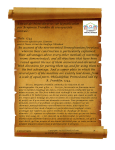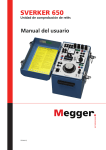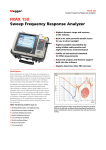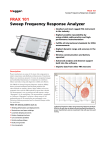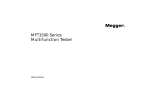Download MOS KIM-4 User manual
Transcript
CHAPTER 1 INTRODUCTION Congratulations on your purchase of a KIM-4 motherboard. You will now be able to add additional memory to your KIM system, as well as EROM, ROM, and other system components as they are introduced by MOS Technology, Inc. Because the KIM-4 motherboard will form the heart of your microcomputer system, interconnecting all of your other system components, please take a few minutes to read this manual completely before attempting to use your KIM-4. Chapter 2 of this manual describes how to install and check out your KIM-4 motherboard. Chapter 3 contains schematics and a brief theory of operation, Chapter 4 contains your warranty information for this module, and Appendix A describes how to use the direct memory access capability incorporated in the motherboard. Appendix B contains a suggested power supply for supplying current to your KIM system. There is one important point you should understand before using your KIM-4 motherboard. Because of the high current involved in supplying power to multiple expansion boards, MOS Technology, Inc. has designed your KIM system so that you may use a single unregulated +8v supply for all the cards which you can mount in your KIM motherboard. +5v supply. Do not attempt to power your KIM system through a regulated Each expansion module provided for the KIM system will contain its own +5v regulator which will require the +8v as input. A regulator is provided on the motherboard to feed regulated +5v to your KIM-1 microcomputer module. This regulator also works off the +8v which you supply to the motherboard. If you do not have a +8v unregulated power supply, refer to Appendix B for a schematic for such a unit. Your KIM-4 motherboard has been carefully designed for years of uninterrupted service to you. If, for any reason, the unit should fail, follow the instructions contained in Chapter 4 to provide service for your module. will be a powerful and useful addition to your KIM system. We hope that the KIM-4 END V I E W CHAPTER 2 INSTALLATION AND CHECKOUT 2.1 Installing the Hardware When you have unpacked your KIM-4, locate the hardware packet and attach the four rubber feet as shown in Figure 1. Then install the twelve card guides with the screws supplied. See Figure 2 for correct placement. If you have one or more KIM expansion modules, put them in each card slot to assure correct placement of the guides. KIM-1. 2.2 Three threaded spacers are provided to elevate your Attach them as shown in Figure 3. Attaching KIM-4 to KIM-1 Using Your Old Power Supply Remove any expansion cards you have placed in KIM-4 and disconnect the female connector attached to the application connector on your KIM-1. (You will also have to disconnect any connector you have mated to the KIM-1 expansion connector.) Carefully slide the KIM application and expansion connector tabs into the two mating female receptacles on the KIM-4 motherboard. Figure 4) (See Remove any connections you have made to the female application connector pins, B, C, D, E, F, H, or J. Remove the jumper connected to pin K. Now attach your old KIM-1 female application connector to the KIM-4 application connector tab as shown in Figure 4. If you have not previously wired a connector for your KIM-1, refer to your KIM-1 User Manual, Chapter 2, for details. For initial checkout of the KIM-4 you can use the power supply you previously connected to KIM-1. The +5v and +12v pins on the KIM-4 application connector are routed directly to the KIM-1, bypassing the regulators on the KIM-4; these voltages are not distributed on the motherboard expansion module connectors. Thus your old +5v and +12v power supply cannot be used to power expansion modules inserted in the motherboard. Turn your old power supply on, depress the reset button on the KIM-1 keyboard, and verify that your KIM still operates normally. If you wish, load a program from your cassette tape interface and verify that it operates correctly. 2.3 Attaching Your New Power Supply to KIM-4 Because the motherboard contains a +5v regulator for your KIM-1 and a +12v regulator for your audio cassette interface, you should power your entire KIM system from a +8v unregulated power supply and a +15v regulated power supply. Attach the ground, +8v, and +15v supplies to the KIM-4 power connector as shown in Figure 5. Some expansion cards provided with the KIM system also require a negative voltage. If you plan on installing such cards you must also connect a -15v supply to the appropriate pin on the KIM-4 power connector. expanded, your KIM system may require as much as 15A of +8v. When fully To avoid voltage drops between your power supply and the KIM-4, make sure that you use a heavy gauge wire for the connection (No. 12 stranded wire is recommended). Before connecting your new power supply to the KIM-4 power connector, remove your old +5v and +12v supplies from pins 1, A and N on the application connector. Disconnect the KIM-1 from your KIM-4 and turn on your new power supply. Measure the voltage between pin 1 and pin A of the KIM-4 application connector and insure that it is +5v. Now measure the voltage between pin 1 and pin N of the KIM-4 application connector and insure that it is + 12v. If all voltages appear correct, turn off your power supply, re-connect the KIM-1 to your KIM-4, and turn your new power supply back on. You should now verify that your KIM-1 is operating correctly. 2.4 Installing Expansion Boards Into Your KIM-4 If you have purchased KIM expansion modules, you can now insert them in the KIM-4 motherboard. Follow the instructions provided in the manual you received with each expansion module. You can verify the operation of each expansion module by following the checkout instruction included in the owner's manual for the expansion module. 2.5 The Bus Expansion Connector On the left-hand end of your KIM-4 there is a bus expansion connector. This connector is provided to allow you to add more modules to the KIM bus if you need to expand beyond the six expansion module connectors provided on the KIM-4. If you have designed modules which you previously connected to the KIM-1 expansion connector, you will find that the same signals previously present on the KIM-1 expansion connector are also present on the KIM-4 bus expansion connector. The wire list provided on the KIM-4 schematic (See Chapter 3) shows the pin connections to the KIM-4 bus expansion connector. Only the lines KO through K7, previously present on the KIM-1 application connector, are not present on the KIM-4 bus expansion connector. CHAPTER 3 THEORY OF OPERATION 3.1 Introduction The KIM-4 motherboard is designed to accomplish three functions. The first function is that of distributing address, data, and control lines from the KIM-1 to the expansion module connectors and the bus expansion connector. Those inter-connections are documented on the interconnection list shown on the schematic diagram. The second function is to buffer, or provide additional drive, for the expansion modules from the address and data buses. The third function is to determine whether the address present on the address bus is addressing a memory location on the KIM-1 module or the KIM-4 motherboard, and supply an appropriate signal to the decode line. The motherboard also contains regulators for the +5v and +12v supplies necessary to operate the KIM-1 and the audio cassette interface. 3.2 Buffering Circuitry U6, U8, and U9 form a 16-bit unidirectional bus buffer for the KIM-1 address lines. These lines will normally be "on" at all times. The output 3.3 Address Decoding and Lockout Circuitry Since some addresses below 2000 (hex) are located on the KIM-1 board, the data bus buffers are used to isolate KIM-1 from the motherboard whenever these addresses below 2000 are issued. This function is provided by U5, which is connected to the three high-order address lines (AB13, 14, 15). If any of those address lines go high (indicating an address above 2000), then the data bus buffers will be enabled in the appropriate direction. The data buffers will also be enabled if an address between 0400 and 13FF (indicated by the Kl, K2, K3, and K4 lines) is present. There are six locations in the memory space which have special significance in any 6502-based system. These are locations FFFA through FFFF. These locations contain the values for the interrupt vectors for the NMI, RST, and IRQ control lines. In the KIM-1 system, these interrupt vectors are stored in locations 17FA - 17FF, the six highest memory locations in KIM-1 since the three highest address lines are not decoded on KIM-1. Since the full KIM system, including the motherboard, does use all sixteen address lines, it is necessary to detect when one of these six highest addresses is issued by the processor and force the data to be read from KIM-1 rather than any memory on the motherboard. This function is provided by U7. Whenever the thirteen high-order address lines are all at logic 1, this condition is detected by U7 and the signal generated is used to disable U5. When U5 is disabled, the decode line generated as the output of U5 goes to a logic 1. This is inverted in U3 and becomes the decode enable line which is fed back to the KIM-1. The motherboard addressing is turned off and the addressing on KIM-1 is turned on, allowing the reset, NMI, and IRQ vectors to be fetched from the high six memory locations in KIM-1. Thus, even with a fully expanded KIM system, these three control vectors will still be under the control of the KIM monitor. CHAPTER 4 WARRANTY AND SERVICE Should you experience difficulty with your KIM-4 module and be unable to diagnose or correct the problem, you may return the unit to MOS Technology, Inc. for repair. 4.1 In-Warranty Service All KIM series Microcomputer Modules are warranted by MOS Technology, Inc. against defects in workmanship and materials for a period of ninety (90) days from date of delivery. During the warranty period, MOS Technology, Inc. will repair or, at its option, replace at no charge components that prove to be defective provided that the module is returned, shipping prepaid, to: KIM Customer Service Department MOS Technology, Inc. 950 Rittenhouse Road Norristown, Pennsylvania 19401 This warranty does not apply if the module has been damaged by accident or misuse, or as a result of repairs or modifications made by other than authorized personnel at the above captioned service facility. No other warranty is expressed or implied. MOS Technology, Inc. is not liable for consequential damages. 4.2 Out-Of-Warranty Service Beyond the ninety (90) day warranty period, KIM modules will be repaired for a reasonable service fee. All service work performed by MOS Technology, Inc. beyond the warranty period is warranted for an additional ninety (90) day period after shipment of the repaired module. 4.3 Policy On Changes All KIM series modules are sold on the basis of descriptive specifications in effect at the time of sale. MOS Technology, Inc. shall have no obligation to modify or update products once sold. MOS Technology, Inc. reserves the right to make periodic changes or improvements to any KIM series module. 4.4 Shipping Instructions It is the customer's responsibility to return the KIM series module with shipping charges prepaid to the above captioned service facility. For in-warranty service, the KIM module will be returned to the customer, shipping prepaid, by the fastest economical carrier. For out-of-warranty service, the customer will pay for shipping charges both ways. The repaired module will be returned to the customer C.O.D. unless the repairs and shipping charges are prepaid by the customer. Please be certain that your KIM module is safely packaged when returning it to the above captioned service facility. APPENDIX A USING DMA WITH THE KIM-4 Some advanced applications involving access to high-speed peripherals such as floppy discs require the ability to stop the processor and allow another device (usually called a 'controller') to gain control of the address and data lines in order to transfer a quantity of data in or out of the memory. This is called DMA or direct memory access. APPENDIX B A KIM SYSTEM POWER SUPPLY The circuit shown in Figure B-l will provide enough current for a fully expanded KIM system - +8v at about ISA. Be sure to wire all components with #10 or heavier wire. A suggested transformer for T h i s the model 16-8 manufactured by Signal Transformer Company. Be sure to wire the two secondary windings in PHASE across the bridge rectifier. The .O1 ohm resistor is composed of a six inch length of #22 wire.



















